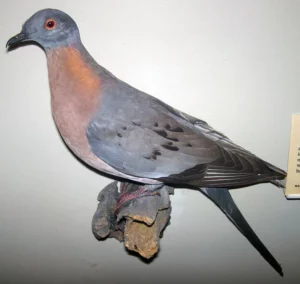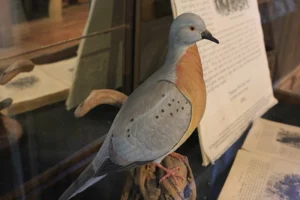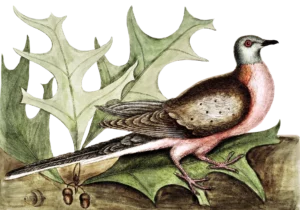Passenger pigeons belong to the Columbiformes family. It used to be widely distributed in North America, but it is no longer visible. However, learning about their traits is interesting.
All the main characteristics of passenger pigeons are listed in the table below. Although we can never see them in real life, we can at least compare their traits to the pictures available online and in books.
| Breed name | Passenger pigeon |
| Scientific name | Ectopistes migratorius. |
| Breed class | Aves |
| Family | Columbiformes |
| Special features | Migratory habit |
| Flying ability | Very good |
| Speed | Fast- 60 mph |
| Colors | Male: Pinkish body and blue-gray head Female: Less vivid but similar to males |
| Size | Male: Up to 16.1 inches Female: Up to 15.7 inches |
| Neck and head | Small |
| Can be kept as pets | These are wild pigeons |
| Mostly (used to be) found in | Across North America |
| Hunted for | Meat |
| Natural predators | Arboreal snakes, weasels, skunks, hawks, and owls |
| Population (approx.) | 3 million to 5 billion |
| Conservations status | Extinct |
After reviewing the fundamental characteristics of passenger pigeons, it’s time to delve deep into the facts surrounding these amazing birds. We intend to learn whatever we can about passenger pigeons.
What is a passenger pigeon?
Passenger pigeons (Ectopistes migratorius), aka wild pigeons, were a distinct species of pigeon we never saw. But, these once existed on Earth. So, let’s find out what these pigeons were.
Passenger pigeons are extinct species of pigeons that once existed in abundance across North America. In the early 1800s, eastern North America was home to billions of these birds. Due to its migratory behavior, this species received its name from the French word passager, which means “passing by.”

These pigeons were larger than the mourning dove and Old World turtledove. They also looked different because they had longer, pointed tails.
Unfortunately, millions of these pigeons were killed each year and transported for sale in urban markets. As a result, starting in 1870, these birds’ populations began to decline rapidly.
How to identify passenger pigeons?
Some of the crucial features that made it easy to identify passenger pigeons include the following.
- Small head and neck
- Long and wedge-shaped tail
- Long and pointed wings
- Large breast muscle
Are passenger pigeons extinct?
Countless animal and bird species have perished on our planet. So, are passenger pigeons also included in that extinct category?
Passenger pigeons have become extinct. Around 108 years ago, the world’s last passenger pigeon died at Ohio’s Cincinnati Zoo. The last passenger pigeon, Martha, after George Washington’s wife, died when she was about 29.
She had a palsy that caused her to tremble, and throughout her life, she never laid an egg. Since she was the final passenger pigeon, her skin was taxidermied, and the Smithsonian Museum acquired her internal organs.
Passenger pigeon extinction causes

Laslovarga (CC BY-SA 4.0) from Wikimedia
Before the arrival of Europeans in North America, passenger pigeons coexisted with the Native Americans. But after the 1800s, their number declined rapidly until they got extinct.
There are mainly two reasons that caused the extinction of passenger pigeons:
- Major commercial utilization of pigeon meat
- Habitat loss due to deforestation
The species was extremely vulnerable to hunting because of its large flocks and cooperative breeding. Populations fell underneath the mark required to maintain the species as the flocks got smaller.
According to biologists, “killing the last pair of a species is not always necessary to drive it to extinction.” And the adaptive living of passenger pigeons proved this statement right. The birds were easy to hunt due to their large flocks and adaptive living preference, and their population began to decline rapidly in the late 19th century.
However, according to experts, the extinction of these birds could have been prevented. Humanity alone is to blame for overhunting and consume excessive these fascinating birds.
Passenger pigeon extinction impacts
The complete extinction of the passenger pigeon species due to overhunting shocked humanity. It undoubtedly affected how we ought to view the natural world.
The only positive outcome of the passenger pigeon’s extinction was increased awareness of the need for stringent conservation regulations. Consequently, since these laws were enacted, we have preserved numerous other migratory birds and wildlife species.
Some interesting facts about extinct passenger pigeons
Although extinct, passenger pigeons held certain facts with them that are worth focusing on. These facts reveal several things about these extinct pigeon species. So, let us probe them.
In honor of the last remaining passenger pigeon, here are a few facts about the extinct passenger pigeon you may not have known.
Passenger pigeons were once abundant.
In the past, North America was home to billions of passenger pigeons. They were so numerous that they once composed about 40% of all birds in North America.
These birds could fly very fast.
Flying at up to 60 mph, passenger pigeons were elegant and extraordinarily nimble in the air.
Their body shape was adapted for speeding.
These pigeons had small heads, wedge-shaped tails, long, pointed wings, and short necks. All of these physical features were perfectly suited for rapid and protracted flights.
Male passenger pigeons were more gorgeous than females.
Male passenger pigeons looked beautiful because of their colorful appearance. Refer to the table above to learn more about the appearance of male passenger pigeons.
Wisconsin housed the largest passenger pigeon nests.
The largest passenger pigeon residence was once thought to be in Central Wisconsin. In Central Wisconsin, it was calculated that 136 million passenger pigeons nested over an area of 850 square miles in 1871.
Noisey
Experts claim that passenger pigeons are loud to the point of being “near-deafening,” which is certainly not pleasant.
Different courtship regimes
Passenger pigeon courtship rituals were distinct from those of other pigeons. For example, the male would vocalize, flutter his wings, and place his head over the neck of the female during their typical courtship rituals. Additionally, none of these activities occurred on the ground but on branches or anywhere high above the ground.
They got extinct due to humans’ thoughtlessness.
Once common passenger pigeons went extinct due to humans’ wild hunting.
Are scientists resurrecting the extinct species of passenger pigeons?

The extinction of passenger pigeons is a living example of the catastrophe that happens when human interests clashed with mother nature.
To undo the extinction, scientists launched the Great Passenger Pigeon Comeback in 2012 to resurrect this extinct species. The Genetic Rescue Toolkit is being used by researchers to try to revive the bird species from extinction.
The following are the three main actions that experts are taking to bring the extinct species of passenger pigeons back to life.
- Genome research
- Revival
- Restoration.
Passenger pigeon vs carrier pigeon
Given the name passenger pigeon, some of us may confuse them with carrier pigeons. But the two pigeon species are different. Want to know those differences? Read below.
The below table lists the differences between a passenger pigeon and a carrier pigeon based on their features/ attributes.
| Features | Passenger Pigeons | Carrier Pigeons |
| Historical importance | No | Yes, as they carried messages across war zones during WW1 and WW2. |
| Specific purposes | No. These were wild species of pigeons in North America. | Yes. These were domesticated rock pigeons that used to carry messages. |
| Genus | Ectopistes | Columba |
| Appearance | Male: Gray to brown backs, bronze to purple or green opalescent necks, and blueish heads with black markings close to the eyes. Female: Similar to males, but their colors were duller. | Orange, golden, or red irises, dark gray heads and necks, green, yellow, or opalescent reddish feathers in the wings, and purple feet. |
| Status | Extinct | Not endangered |
Summary
So, before we go, we’d like to state that passenger pigeons were indeed fascinating bird species. And if they had lived today, we could have provided them with a more secure environment for nesting and rearing. However, we can learn from our mistakes and take steps to conserve other animals and birds to prevent further species extinction.
